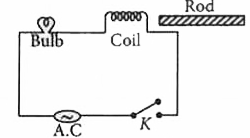Two spheres carrying charges +6μCand9μC , seperated by a distance d , experience a force of repulsion F . When a charge of −3μC is given to both the sphere and kept at the same distance as before , the new force of repulsion is Solution in Kannada
3F
F9
F
F3
The correct Answer is:D
Let us call spheres as A and B .

According to Coulomb's law , the force repulsion between A and B seperated by a distance d is
F=14πε0(+CμC)(+9μC)d2 ….(i)
When a charge −3μC is given to both the spheres , then charge on A6μC−3μC
=+3μC
and on B=+9μC−3μC=+6μC
Again by Columb's law , the new force of distance d is
F'=14πε0(+3μC)(+6μC)d2 ....(ii)
Dividing eqn . (ii) by eqn . (i) we get ,
F'F=14πε0(+3μC)(+6μC)d214πε0(+6μC)+(9μC)d2
=(+3μC)(+6μC)(+6μC)(+9μC)=13
or F ' = F/3
Topper's Solved these Questions
Similar Questions
A solenoid length 0.4cm, radius 1 cm and 400 turns of wire. If a current of 5 A is passed through this solenoid, what is the magnetic field inside the solenoid ?
02:34View SolutionIn the A. C. circuit shown, keeping 'K' pressed, if an iron rod is inserted into the coil, the bulb in the circuit
 05:25View Solution
05:25View SolutionTwo spheres carrying charges +6muC and +9muC , separated by a distance d, experiences a force of repulsion F. When a charge of -3muC is given to both the spheres and kept at the same distance as before, the new force of repulsion is
06:05View SolutionIf two identical spheres having charge 16 mu C and -8 mu C are kept at certain distance apart , then the force if F. They are touched and again kept at the same distance , the force becomes.
04:36View Solutionदो समान धातु के गोले + 10μC एवं - 20μC आवेश से आवेशित किये गये हैं। यदि इनकों एक- दूसरे के सम्पर्क में लाकर अलग कर पुन: उसी दूरी पर रख दिया जाये तब दोनों अवस्थाओं में बल का अनुपात ज्ञात कीजिए।
02:56View SolutionA sphere carrying a charge of -20 mu C is placed at a certain distance from another identical sphere carrying a charge of +80 mu C .The two spheres are brought in contact, separated and kept in their original positions.The ratio of the forces between them before and after they are in contact is
03:02View SolutionTwo tiny conducting spheres are identical any carry charges of -20.0 mu C and +50.0 muC . They are separated by a distance of 2.50 cm. The spheres are brought into contact and then separated to a distance of 2.50 cm. Determine the magnitude of the force that each sphere now experiences, and state whether the force is attractive or repulsive.
03:12View SolutionThe electrostatic force on a small sphere of charge 0.4μC due to another small sphere of charge −0.8μC in air is 0.2N. (a) What is the distance between the two spheres ?(b) What is the force on the second spere due to the first ?
03:05View SolutionThe electrostatic force on a small sphere of charge 0.4 mu c due to the distance bwtwen the two spheres (b) what is the force on the second spere due to the first
04:26View SolutionThe electrostatic force on a small sphere of charge 0.4μC due to another small sphere of charge −0.8μC in air is 0.2 N.
What is the force on the second sphere due to the first?03:40View SolutionTwo spheres carrying charges +6muC and +9muC , separated by a distance d, experiences a force of repulsion F. when a charge of -3muC is given to both the spheres and kept at the same distance as before, the new force of repulsion is
02:11View SolutionCapacitance of a sphere A is 4μF while of another sphereB ,it is 8μF .If on sphere A ,there is a charge 2μC and on B the charge is 4μC ,then the ratio of potential of the spheres is
04:29View SolutionIf two identical spheres having charge 16μC and −8μC are kept at certain distance apart , then the force if F. They are touched and again kept at the same distance , the force becomes.
05:16View SolutionThe force of interaction between two charges q_(1)=6 mu C and q_(2)=2 mu C is 12N .If charge q=-2 mu C is added to each of the charges,then the new force of interaction is
03:41View SolutionThe electrostatic force on a small sphere of charge 0.4 mu C due to another small sphere of charge -0.8 mu C in air is 0.2 N. What is the distance between the two spheres?
04:28View Solution

